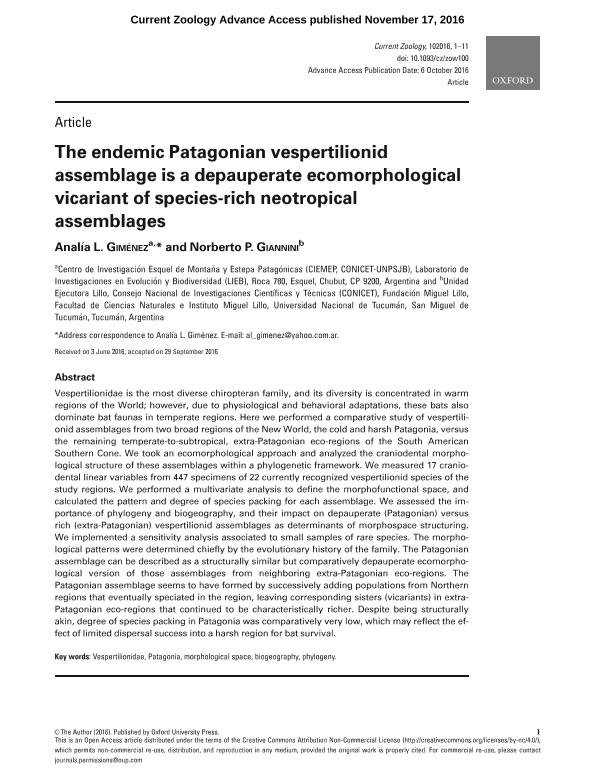Mostrar el registro sencillo del ítem
dc.contributor.author
Giménez, Analía Laura

dc.contributor.author
Giannini, Norberto Pedro

dc.date.available
2018-08-22T16:58:57Z
dc.date.issued
2017-10
dc.identifier.citation
Giménez, Analía Laura; Giannini, Norberto Pedro; The endemic Patagonian vespertilionid assemblage is a depauperate ecomorphological vicariant of species-rich neotropical assemblages; Oxford University Press; Current Zoology; 63; 5; 10-2017; 495-505
dc.identifier.issn
1674-5507
dc.identifier.uri
http://hdl.handle.net/11336/56581
dc.description.abstract
Vespertilionidae is the most diverse chiropteran family, and its diversity is concentrated in warm regions of the World; however, due to physiological and behavioral adaptations, these bats also dominate bat faunas in temperate regions. Here we performed a comparative study of vespertilionid assemblages from two broad regions of the New World, the cold and harsh Patagonia, versus the remaining temperate-to-subtropical, extra-Patagonian eco-regions of the South American Southern Cone. We took an ecomorphological approach and analyzed the craniodental morphological structure of these assemblages within a phylogenetic framework. We measured 17 craniodental linear variables from 447 specimens of 22 currently recognized vespertilionid species of the study regions. We performed a multivariate analysis to define the morphofunctional space, and calculated the pattern and degree of species packing for each assemblage. We assessed the importance of phylogeny and biogeography, and their impact on depauperate (Patagonian) versus rich (extra-Patagonian) vespertilionid assemblages as determinants of morphospace structuring. We implemented a sensitivity analysis associated to small samples of rare species. The morphological patterns were determined chiefly by the evolutionary history of the family. The Patagonian assemblage can be described as a structurally similar but comparatively depauperate ecomorphological version of those assemblages from neighboring extra-Patagonian eco-regions. The Patagonian assemblage seems to have formed by successively adding populations from Northern regions that eventually speciated in the region, leaving corresponding sisters (vicariants) in extra- Patagonian eco-regions that continued to be characteristically richer. Despite being structurally akin, degree of species packing in Patagonia was comparatively very low, which may reflect the effect of limited dispersal success into a harsh region for bat survival.
dc.format
application/pdf
dc.language.iso
eng
dc.publisher
Oxford University Press
dc.rights
info:eu-repo/semantics/openAccess
dc.rights.uri
https://creativecommons.org/licenses/by-nc-sa/2.5/ar/
dc.subject
Biogeography
dc.subject
Morphological Space
dc.subject
Patagonia
dc.subject
Phylogeny
dc.subject
Vespertilionidae
dc.subject.classification
Otras Ciencias Biológicas

dc.subject.classification
Ciencias Biológicas

dc.subject.classification
CIENCIAS NATURALES Y EXACTAS

dc.title
The endemic Patagonian vespertilionid assemblage is a depauperate ecomorphological vicariant of species-rich neotropical assemblages
dc.type
info:eu-repo/semantics/article
dc.type
info:ar-repo/semantics/artículo
dc.type
info:eu-repo/semantics/publishedVersion
dc.date.updated
2018-08-21T12:55:29Z
dc.journal.volume
63
dc.journal.number
5
dc.journal.pagination
495-505
dc.journal.pais
China

dc.journal.ciudad
Beijing
dc.description.fil
Fil: Giménez, Analía Laura. Consejo Nacional de Investigaciones Científicas y Técnicas. Centro Científico Tecnológico Conicet - Patagonia Norte. Centro de Investigación Esquel de Montaña y Estepa Patagóica. Universidad Nacional de la Patagonia "San Juan Bosco". Facultad de Ciencias Naturales - Sede Esquel. Centro de Investigación Esquel de Montaña y Estepa Patagónica; Argentina
dc.description.fil
Fil: Giannini, Norberto Pedro. Consejo Nacional de Investigaciones Científicas y Técnicas. Centro Científico Tecnológico - Tucumán. Unidad Ejecutora Lillo; Argentina. Universidad Nacional de Tucumán; Argentina. Fundación Miguel Lillo; Argentina
dc.journal.title
Current Zoology
dc.relation.alternativeid
info:eu-repo/semantics/altIdentifier/doi/https://dx.doi.org/10.1093/cz/zow100
dc.relation.alternativeid
info:eu-repo/semantics/altIdentifier/url/https://academic.oup.com/cz/article/63/5/495/3057039
Archivos asociados
